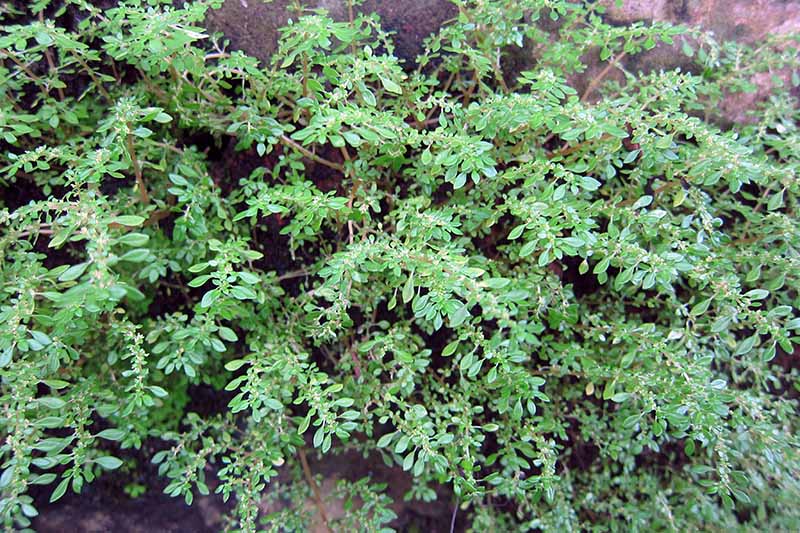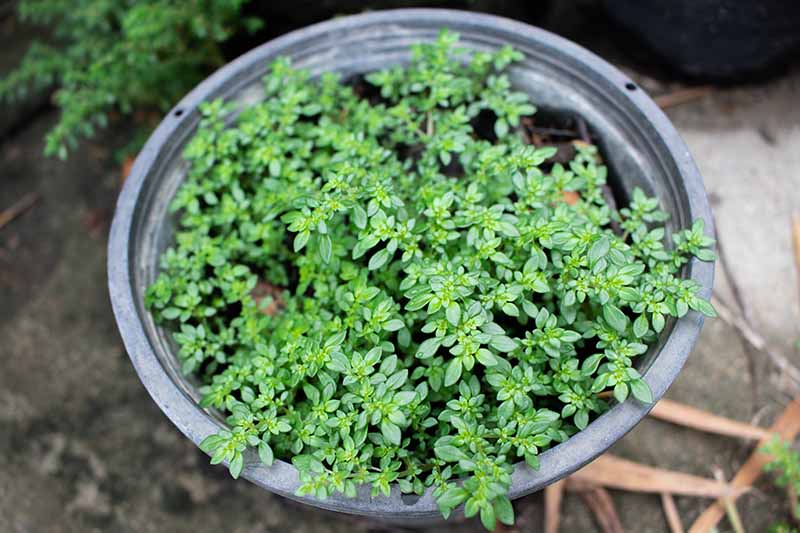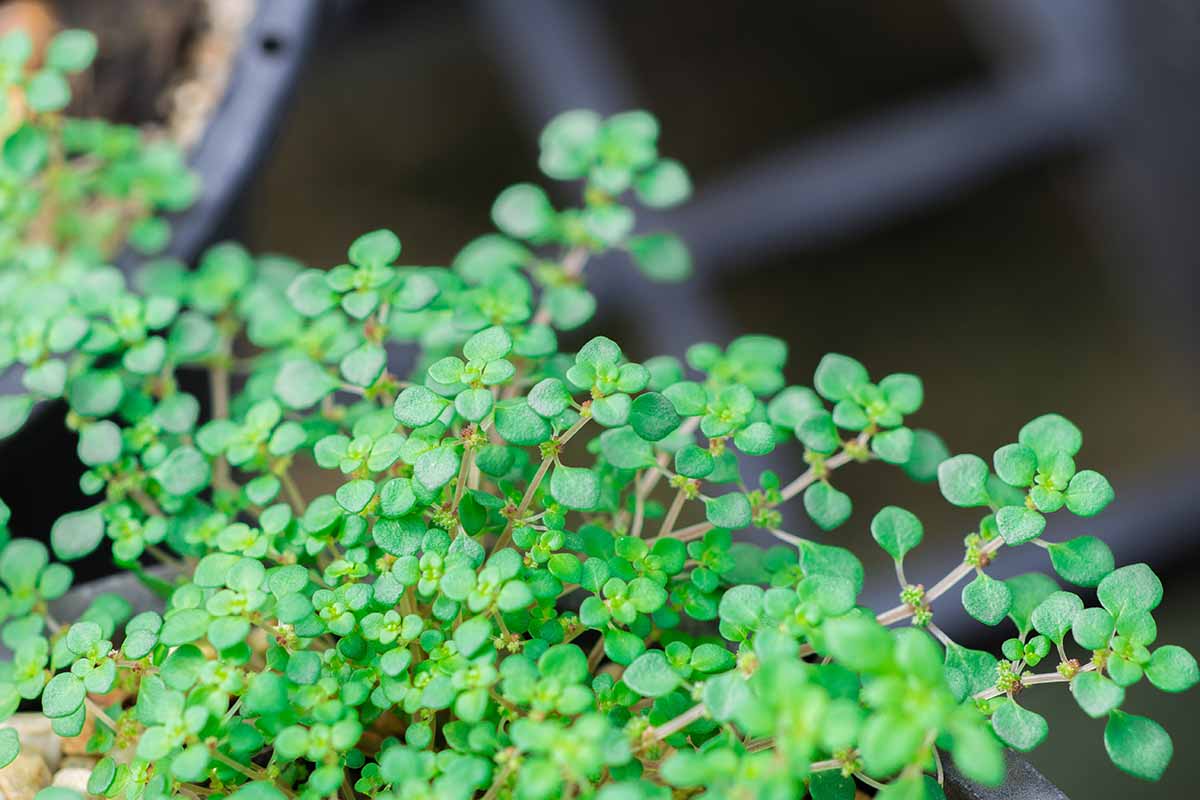Ornamental artillery plant, Pilea microphylla, aka gunpowder or pistol plant, military fern, or rockweed, is an herbaceous perennial.
It is one of about 600 types of non-stinging Pilea species in the Urticaceae, or nettle family.
This tropical species thrives outdoors year-round in Zones 11 to 12 as a short-lived evergreen perennial. It is also grown as an outdoor annual or indoor houseplant in all zones.
We link to vendors to help you find relevant products. If you buy from one of our links, we may earn a commission.
In this article, we’ll discuss all you need to know to grow and care for your own artillery plant indoors.
It has a creeping growth habit and may reach mature dimensions of six to 18 inches high and 12 to 24 inches wide.
The artillery species has plump leaves like a succulent. They are either green or variegated pink and white, one-eighth to one-half inch long, and “obovate,” or rounded and narrower at the base. The leaves are arranged in opposing pairs, like a fern frond.
In nature, the species produces tiny pinkish flowers followed by brown fruits. And while flowering is unlikely to occur indoors, it’s fun to know about it because the names “artillery,” “gunpowder,” “military,” and “pistol” come from an unusual characteristic.
There are both male and female flowers, and the males literally propel pollen into the air, as in an aerial attack.
Historically speaking, the artillery species has undergone numerous botanical reclassifications by Swedish botanist Carl Linnaeus and later botanists, including Parietaria microphylla (1759), Pilea muscosa (1821), P. microphylla (1851), and P. trianthemoides var. microphylla (1869).
These synonyms and “basionyms,” or name equivalents and their predecessors, still pop up in plant searches, so it’s good to be familiar with them.
The artillery species is native to the Caribbean, Mexico, Central and South America, and the southeastern United States.
In its native habitat, it is a somewhat weedy, spreading ground cover that commonly sprouts between rocks and in lawns, in margins between land and water, and in masonry crevices.
The species has been introduced around the world, and is classified as invasive or at high risk for becoming invasive in many places because it readily naturalizes via stolons, or runner roots, as well as self-sown seed.
Today’s cultivated varieties are robust versions of the hardscrabble wild species. And while indoor cultivation does not pose a threat to the landscape, we do not recommend letting P. microphylla spend the summer outdoors in temperate zones as we do with many houseplants, in order to avoid inadvertently introducing it to the landscape.
This tropical species thrives best with a daytime temperature range of 65 to 85°F and 1000 to 2000 foot-candles of daylight, which is another way of saying bright indirect light.
Lower light is well-tolerated but usually causes shading to dark green, so don’t waste money on a variegated variety if you choose a dim location for your plant.
And growth may be more horizontal than upright. A little pruning of leggy stems contributes to a more compact form.
If you have a very dim setting, such as a windowless office, that you wish to add a plant to, you’ll need a grow light.
To grow your own P. microphylla, you’ll need to start from seed, take a stem cutting from an existing plant, divide an existing plant, or purchase a nursery start.
Outdoors, this is a vigorous self-sower that disperses tiny seeds with gusto, contributing to its invasive tendencies.
However, starting from seed may pose a challenge, as most retailers sell live plants and seeds can be hard to come by.
Use a Hanging Artillery Plant to Freshen Up Your Space
Adding greenery to your home is an excellent way to bring life and vitality into your living space. Not only do houseplants purify the air, but they also have numerous health and mood boosting benefits. One of the best plants to hang in your home for a fresh new look is the artillery plant. With its cascading leaves and easy care nature, the artillery plant is ideal for both beginners and expert gardeners looking to incorporate something new into their plant collection. In this article, we will discuss everything you need to know about choosing, caring for and creatively displaying a hanging artillery plant to freshen up your indoor space.
What is an Artillery Plant?
The artillery plant, scientifically known as Pilea microphylla, is a charming houseplant native to tropical regions of Central and South America. It gets its unusual common name from the way it disperses its seeds. The small, round leaves of the artillery plant grow along trailing stems that can reach up to 3 feet long. This gives the plant a cascading, weeping effect when allowed to trail out of a hanging basket or pot. The leaves are typically a bright lime green or have variegated white coloration.
One of the best features of the artillery plant is its adaptability to various growing conditions. It thrives in moderate humidity and filtered sunlight. The plant also has relatively low watering and feeding needs, making it great for beginners or busy plant parents. When cared for properly, this unique houseplant will provide you with endless trailing vines full of lively foliage to show off in your home.
Benefits of the Hanging Artillery Plant
There are many excellent benefits to adding an artillery plant to your home décor. Here are some of the top reasons to use a hanging artillery plant to freshen up your space:
-
Air Purification – The lush leaves of the artillery plant help filter indoor air by absorbing toxins and releasing oxygen. This improves air quality and creates a healthier home environment.
-
Stress Relief – Having greenery and living plants in your home has been shown to reduce stress, lower blood pressure and boost overall mood and wellbeing.
-
Easy Care – The artillery plant has low maintenance needs when it comes to water, light and feeding. This makes it ideal for beginners or anyone with a busy schedule.
-
Versatile Placement – A hanging artillery plant can be used in many different rooms and displays thanks to its cascading shape and bright pop of color.
-
Unique Style – The flowing vines and tropical inspiration of an artillery plant add beauty and interest to any space in need of revitalization.
Caring for Your Artillery Plant
Caring for an artillery plant is fairly simple, especially when compared to other houseplant varieties. Here are some basic care tips to keep your artillery plant healthy and help it thrive:
Light
The artillery plant does best in bright, filtered light. Near an east or west facing window is ideal. Direct hot sunlight can scorch the leaves, so provide shade if needed.
Water
Allow the top inch or two of soil to dry out between waterings. The plant enjoys consistent moisture but does not like soggy or waterlogged soil. Water less frequently in the winter when growth slows.
Temperature & Humidity
Average room temperature between 65-80°F is suitable. Higher humidity is appreciated, so mist the plant daily or use a pebble tray.
Soil
Use a well-draining potting mix and repot annually in the spring to provide fresh soil and nutrients.
Fertilizer
Feed monthly during spring and summer with a balanced liquid fertilizer diluted to half strength. Reduce feeding in fall and winter.
Pruning
Pinch back leggy stems to encourage bushier growth. Remove any dead or damaged foliage as needed to maintain an attractive appearance.
Common Problems
Artillery plants are not susceptible to many issues when given proper care. Potential problems include root rot from overwatering, mealybugs, aphids and leaf spot fungus. Isolate affected plants and use eco-friendly treatments as needed.
Displaying Your Hanging Artillery Plant
One of the best qualities of an artillery plant is how the long, trailing vines lend themselves perfectly to hanging displays. Get creative with how you showcase your plant to get the full impact of its fresh, cascading style. Here are some fun ideas:
-
Hang the plant in an entryway, above cabinets or alongside a window for a tropical look.
-
Display multiple artillery plants on a multi-tiered plant stand at varying lengths for dimension.
-
Let the vines trail down a bookcase or tall shelf for an indoor living wall effect.
-
Use macramé hangers, hoop holders or moss poles to suspend artillery plants in unexpected places like corners or ceilings.
-
Arrange artillery plant cuttings in clear glass vases or jars for inexpensive DIY decor.
-
Set pots on bar carts, console tables, mantels or desks to soften hard edges and add life.
-
Group a few artillery plants on a plant caddy with wheels to create a movable indoor garden.
-
Weave vines through baskets, ladders, wreaths and other frames for bohemian or eclectic displays.
-
Pair artillery plants with other trailing plants like ivy or philodendrons for luscious layered textures.
The graceful, flowing style of the artillery plant makes it a gorgeous addition to any area of your home in need of a fresh pop of green. Whether you want to purify the air, add life to your decor or benefit from having more live plants around, a hanging artillery plant is sure to do the trick. With the right care and creative placement, this whimsical houseplant can help freshen up your living space and bring vitality to your indoor botanical collection.

From a Nursery Start/Transplanting
When you buy a pilea, it may be very young or more mature. To transplant it to another container, or to pot up a stem cutting or division, do the following:
Choose a vessel that is large enough to accommodate the plant, whatever its size, with two to three inches of growing room all around it. Be sure that it has one or more drainage holes.
Keep in mind that when it’s mature, this type of pilea may be between 12 and 24 inches wide. You will probably need to repot more than once before maturity and may want to keep the early containers on the inexpensive side.
At maturity, you may opt to select a hanging container to showcase the species’ creeping, trailing nature.
Buy potting soil that’s rich in organic matter, moisture-retentive, loose and airy, and well-draining. It will approximate the 5.0 to 6.0 pH that this tropical species prefers.
Place a single layer of pea gravel in the bottom to facilitate drainage, and then fill the vessel about halfway with potting soil.
Gently unearth the plant from its current pot.
Settle it in the potting medium so it sits at the same depth it was in the original container.
Backfill with soil and tamp it very lightly to hold the plant upright. Take care not to compact the soil. Light and airy is what you want to aim for.
If you are potting a rooted stem cutting, settle it in the soil, taking care not to injure the fledgling roots.
Bury the rooted end one inch deep in soil, tamp lightly and loosely backfill.
To transplant a division, you’ll want to settle it in much the same way, with about an inch of soil over the roots, at about the same height it was in its original vessel.
After potting, water until it runs out the bottom of the vessel, and repeat.
When all drainage has stopped, find a location with bright, indirect light. You may want to place the container on a single layer of pea gravel in a shallow, non-rusting pan. Add water to the pan until it comes just to the top of the gravel.
This is a great way to increase ambient humidity and replicate the natural habitat of a pilea plant.
One final note: With stems that are fleshy like a succulent, it’s easy to bruise or break them, so be sure to handle yours with care.
Once potted and watered, it’s time to apply a half-strength liquid or slow-release granular houseplant food. It’s best to apply this to wet soil to avoid burning tender roots and stems.

Feed again in the summer, and continue to feed once in spring and once in summer going forward.
Some gardeners recommend feeding more frequently, but overfeeding may prove to be a disaster resulting in a visible buildup of salts on the soil and container that inhibits water uptake.
In the event of a buildup, flush the pot through several times with water, and reduce feeding to once a year in the spring.
Keep the soil evenly moist by watering when the surface feels dry. Avoid oversaturation, as the roots rot easily, and reduce watering during winter dormancy. Just don’t let the pot completely dry out.
In addition, avoid wetting the leaves, especially in low-light locations, to avoid creating a breeding ground for the bacterial and fungal diseases we’ll discuss shortly.
P. macrophylla is not hard to grow when you remember to:
- Use an organically-rich potting soil that is loose, well-draining, and moisture-retentive.
- Avoid packing the soil down hard when potting. Instead, tamp loosely and leave lots of air holes to facilitate the flow of nutrients, oxygen, and water.
- Fertilize sparingly to avoid a buildup of salts, and flush several times as needed in the event of overfeeding.
- Maintain even moisture without oversaturation by watering when the soil surface feels dry.
This is an easy species to maintain. For a more compact shape, pinch off a few inches of the growing tips. If you like, use them to make new plants per the propagation instructions above.

If a fragile stem breaks, use clean pruners to remove the damaged portion. Be sure to cut just above a leaf node to encourage rapid regeneration.
Also, tap water is sometimes so alkaline or “hard” that it causes white spots to form on the leaves. If you note this issue, switch to distilled water.
Like many houseplants of tropical origin, P. microphylla thrives in bright, indirect light but it can tolerate a low-light placement.
Photo by Daderot, Wikimedia Commons, via
P. microphylla ‘Variegata’ is a variegated pink and white cultivar you may like to choose for a location with bright indirect light.
P. microphylla ‘Variegata.’ Photo by Forest & Kim Starr, Wikimedia Commons, via
For best results in low light, remember that a green variety is your best bet, as a variegated one is likely to shade to dark green anyway.
This species has not been widely developed, and options and availability are currently not extensive.
Managing Pests and Disease
With indoor cultivation, you are not likely to face many issues. Some common houseplant pests prefer very dry environments, while fungi and bacteria favor dampness.
Try to keep the indoor humidity at or above 45 percent, and avoid both under- and overwatering as well as direct sunlight.
Even with the best care, pests may appear. You may encounter:
Some are more likely to prey upon flora grown outdoors, but you should be aware of the possibilities.
If a stream of running tap water doesn’t dislodge the offending insects, try one or more of the following:
Treat sapsuckers and caterpillars with an application of organic neem oil.
Apply food-grade diatomaceous earth to the soil. It addresses sapsuckers as well as flying pests and gastropods, and remains in the potting medium as a preventative measure against future infestation.
Place yellow sticky tape products formulated specifically for trapping flying pests near affected pots.
In the event of an extensive infestation, you may have to remove severely damaged foliage by cutting stems just above a leaf node or at the base.
As for diseases, the following are known to afflict P. microphylla:
- Anthracnose (Colletotrichum spp.)
- Myrothecium Leaf Spot (Myrothecium roridum)
- Pythium Root Rot (Pythium spp.)
- Rhizoctonia Aerial Blight (Rhizoctonia solani)
- Southern Blight (Sclerotium rolfsii)
- Xanthomonas Leaf Spot (Xanthomonas campestris)
As we said, indoor specimens are less likely to suffer from these ailments than plants grown outdoors.
However, if yours should become infected, there are both chemical and biological treatments for fungal and bacterial conditions that you can try.
If the damage is extensive, it is often better to discard the plant and sanitize the pot with a 10-percent bleach to water solution (one part bleach to nine parts water).
Pilea Microphylla Artillery plant care & Tips.
FAQ
What is an Artillery Plant good for?
How often should I water an artillery fern?
Is artillery fern toxic to cats?
Is artillery fern invasive?
Are artillery plants hardy?
Hardiness: It is hardy in USDA zones 11-12 and is typically grown as an annual or indoor plant in cooler climates. Uses: The Artillery Plant is used as an ornamental plant in rock gardens, terrariums, and as a ground cover in warm climates. It’s also popular as a houseplant due to its adaptability and ease of care.
How do you care for an artillery plant?
The Artillery Plant is generally easy to care for, but like all plants, it can encounter pests, diseases, and common problems. Spider Mites: These tiny pests can be identified by the fine webs they weave on the plant. They cause yellowing or speckled leaves. Increase humidity around the plant and wash it with a strong stream of water.
Is artillery a nettle?
It belongs to the nettle family (Urticaceae) and is part of a diverse genus with over 600 species. Plant Type and Habit: The Artillery Plant is an evergreen perennial plant with a creeping habit.
What is an artillery plant?
It’s also known for the explosive pollen discharge from its minuscule flowers, earning it the nickname “Artillery Plant.” Native: This plant is native to the tropical regions of Central and South America, where it thrives in warm, humid conditions. It belongs to the nettle family (Urticaceae) and is part of a diverse genus with over 600 species.
